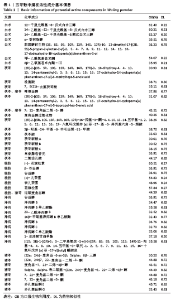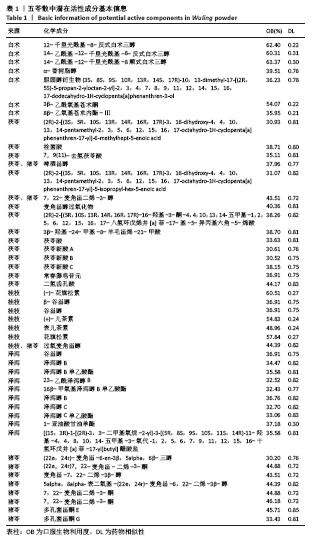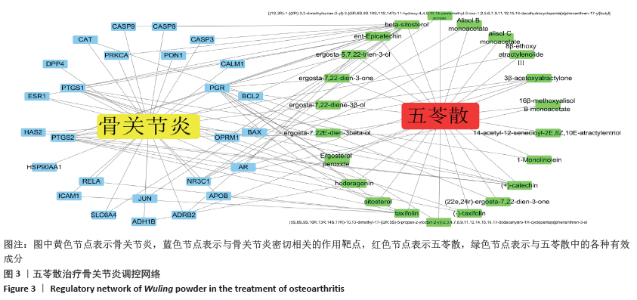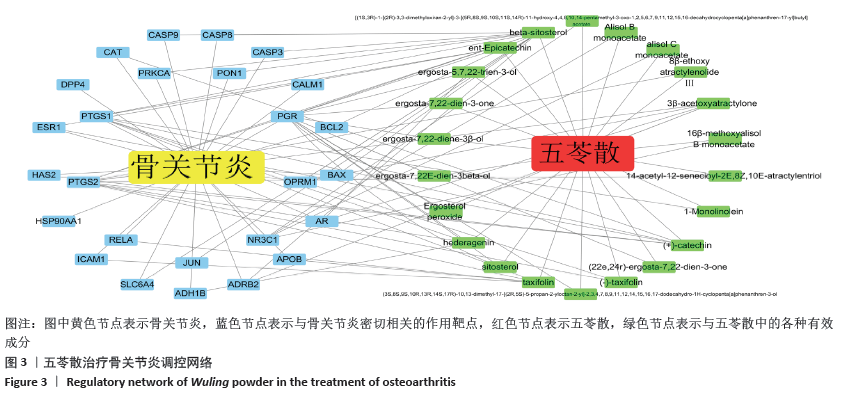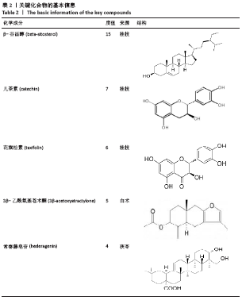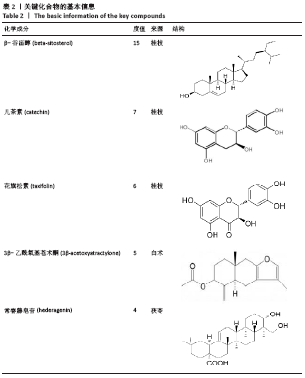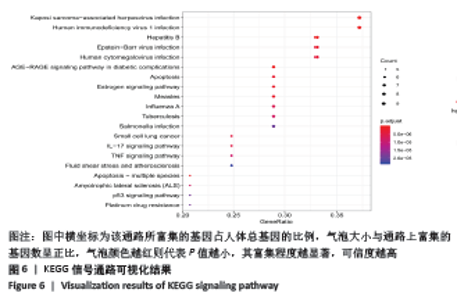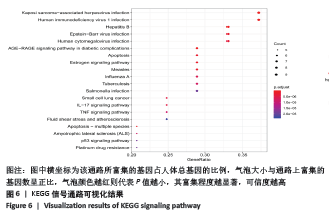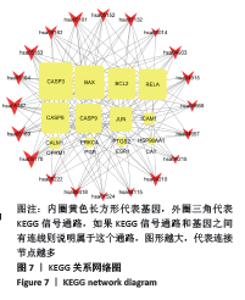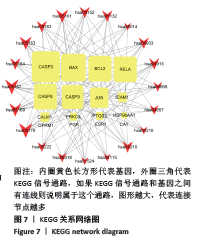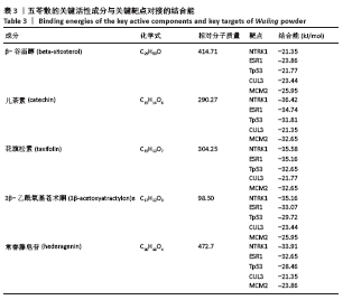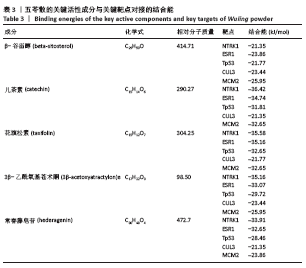Chinese Journal of Tissue Engineering Research ›› 2021, Vol. 25 ›› Issue (20): 3185-3193.doi: 10.3969/j.issn.2095-4344.3203
Previous Articles Next Articles
Potential molecular mechanism of Wuling powder in treating osteoarthritis based on network pharmacology and molecular docking
Song Shilei, Chen Yueping, Zhang Xiaoyun, Li Shibin, Lai Yu, Zhou Yi
- Ruikang Hospital Affiliated to Guangxi University of Chinese Medicine, Nanning 530011, Guangxi Zhuang Autonomous Region, China
-
Received:2019-12-23Revised:2019-12-28Accepted:2020-07-26Online:2021-07-18Published:2021-01-15 -
Contact:Zhang Xiaoyun, Master, Attending physician, Ruikang Hospital Affiliated to Guangxi University of Chinese Medicine, Nanning 530011, Guangxi Zhuang Autonomous Region, China -
About author:Song Shilei, Master candidate, Ruikang Hospital Affiliated to Guangxi University of Chinese Medicine, Nanning 530011, Guangxi Zhuang Autonomous Region, China -
Supported by:the National Natural Science Foundation of China, No. 81760796, 81960803 (both to CYP); Guangxi Natural Science Foundation, No. 2015GXNSFAA139136 (to CYP); Key Project of Guangxi Health Department, No. S201419-05 (to CYP); Guangxi University Young Teachers’ Basic Ability Improvement Project, No. 2019KY0352 (to ZXY); 2019 School-level Scientific Research Project of Guangxi University of Chinese Medicine, No. 2019QN027 (to ZXY); Self-Financing Project of Guangxi Administration of Traditional Chinese Medicine, No. GZZC2019096 (to ZXY); First-level Discipline Project of Guangxi University of Chinese Medicine, No. 2019XK029 (to ZXY); 2016 National Famous Traditional Chinese Medicine Heritage Studio Construction Project & Qihuang Engineering Project for High-level Talent Team Cultivation of Guangxi University of Chinese Medicine, No. 2018004
CLC Number:
Cite this article
Song Shilei, Chen Yueping, Zhang Xiaoyun, Li Shibin, Lai Yu, Zhou Yi. Potential molecular mechanism of Wuling powder in treating osteoarthritis based on network pharmacology and molecular docking[J]. Chinese Journal of Tissue Engineering Research, 2021, 25(20): 3185-3193.
share this article
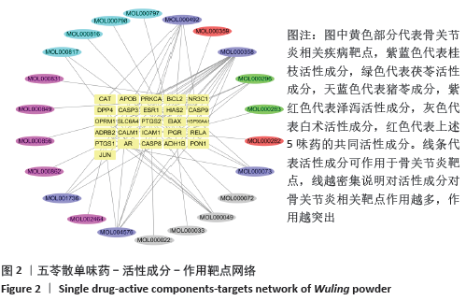
2.3 “单味药-活性成分-作用靶点”网络 根据上述分析所得的潜在作用靶点的预测结果,运用Cytoscape软件中的“merge”功能构建“五苓散单味药-活性成分-作用靶点”网络,见图2。网络总共包括48个节点(22个活性成分节点和26个靶点节点)和60条边,不同颜色的椭圆形代表不同的药物,每条边表示单味药活性成分与作用靶点之间的关系。同时构建“五苓散治疗骨关节炎的调控网络”,见图3。该网络中度值排名前5位的化合物分别是β-谷甾醇(beta-sitosterol)、儿茶素(catechin)、花旗松素(taxifolin)、3β-乙酰氧基苍术酮(3β-acetoxyatractylone)、常春藤皂苷(hederagenin)分别能与15,7,6,5,4个靶点连接,对治疗骨关节炎具有重要的意义,其基本信息见表2。 "
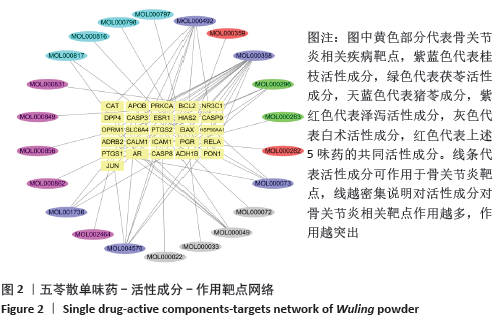

2.4 PPI网络及网络拓扑分析结果 借助Bisogenet(Version 3.0.0)中的DIP,BIOGRID,HPRD,INTACT,MINT,BIND等各大数据库和Cytoscape软件来处理共有蛋白基因,初步得到一个2 738个节点、63 635条边的PPI网络图。再运用Cytoscape中的CytoNCA插件,以DC>61进行1次筛选,得到一个648个节点、26 153条边的 PPI网络图,再以Betweenness值(BC)>4 000进行2次筛选,得到一个12个节点、40条边的PPI网络图,其过程见图4。度值越高,在整个网络中起到的作用越大,度值排名前5的蛋白基因为神经营养酪氨酸受体激酶1(Neurotrophic Receptor Tyrosine Kinase 1,NTRK1)、雌激素受体1(Estrogen Receptor 1,ESR1)、肿瘤蛋白p53(Tumor Protein p53,Tp53)、泛素连接酶CUL3蛋白(Cullin3,CUL3)微小染色体维持蛋白2(Minichromosome Maintenance Complex Component 2,MCM2)。这些度值较大的蛋白基因在整个网络中起着关键的作用。同时这些蛋白基因所对应的靶点可能是五苓散治疗骨关节炎的关键靶点。 "
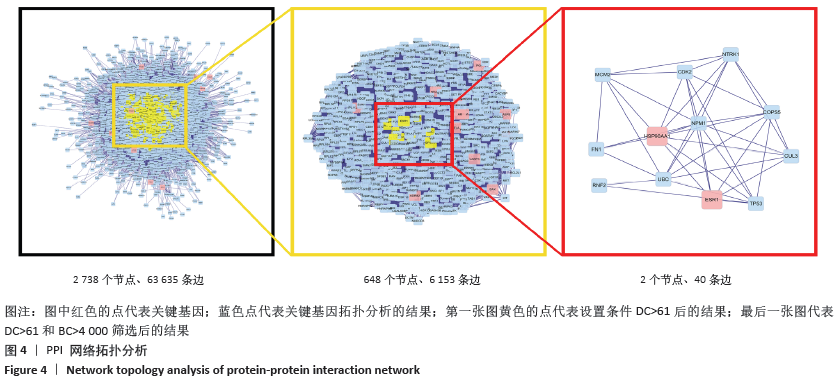
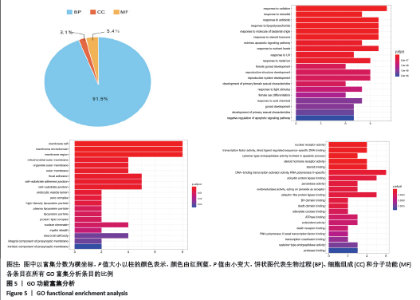
2.5 GO和KEGG富集分析结果 GO富集分析得到GO条目(P < 0.05)共709个,包括生物过程(BP)649个、细胞成分(CC)22个和分子功能(MF)38个,并依据P值排序选取每个模块排名前20位的条目,见图5。最终结果提示,生物学过程的相关条目与对辐射的反应(response to radiation )、对雌二醇的反应(response to estradiol)、对抗生素的反应(response to antibiotic)、对脂多糖的反应(response to lipopolysaccharide )、对细菌来源分子的反应(response to molecule of bacterial origin )等有关;细胞成分的相关条目主要包括膜筏(membrane raft)、膜微区(membrane microdomain)、膜区(membrane region)、线粒体外膜(mitochondrial outer membrane)、细胞器外膜(organelle outer membrane)等;分子功能的相关条目主要包括核受体活性(nuclear receptor activity)、转录因子活性(transcription factor activity)、半胱氨酸型内肽酶活性与细胞凋亡的关系(cysteine-type endopeptidase activity involved in apoptotic process)、类固醇激素受体活性(steroid hormone receptor activity)等。 "

| [1] 贺自克,王上增,沈锦涛.基于Hedgehog通路探讨补肾活血方对实验性膝骨性关节炎兔退变软骨的保护作用[J].中国病理生理杂志,2020,36(4):700-706. [2] 钱凯,杜彦仪,韩隆胤,等.基于网络药理学探讨五苓散治疗类风湿关节炎的作用机制[J].中国实验方剂学杂志,2019, 25(19):138-146. [3] ABRAMOFF B, CALDERA FE. Osteoarthritis: pathology, diagnosis, and treatment options. Med Clin North Am. 2020;104(2): 293-311. [4] HAO DA C, XIAO PG. Network pharmacology: a Rosetta Stone for traditional Chinese medicine. Drug Dev Res. 2014;75(5): 299-312. [5] 张彦琼,李梢.网络药理学与中医药现代研究的若干进展[J].中国药理学与毒理学杂志,2015,29(6):883-892. [6] 段贤春,黄石,彭代银,等.网络药理学在中药复方研究中的应用[J].中国药理学通报,2020,36(3):303-308. [7] 曲凡,杨锡燕.五苓散合黄连解毒汤加减治疗难治性高血压的临床效果[J].中国老年学杂志,2020,40(4):692-694. [8] 汝锦龙.中药系统药理学数据库和分析平台的构建和应用[D].咸阳:西北农林科技大学,2015. [9] 胡聪,黎红维,吴琳静,等.基于网络药理学的苍耳散治疗鼻炎作用机制研究[J/OL].中华中医药学刊:1-19[2020-06-14]. http://kns.cnki.net/kcms/detail/21.1546.R.20200108.1307.019.html. [10] 浦冬青,刘政,梁佳玮,等.基于网络药理学及分子对接探讨热毒宁注射液抑制新型冠状病毒肺炎炎症风暴机制[J/OL].中药药理与临床:1-17[2020-06-14]. https://doi.org/10.13412/j.cnki.zyyl.20200603.001. [11] 廖姿,张家琼,付先芸,等.基于网络药理学的“大黄-桃仁”配伍治疗子宫腺肌病的作用机制研究[J/OL].中国中药杂志:1-10[2020-06-14]. https://doi.org/10.19540/j.cnki.cjcmm.20200520.403. [12] 耿玮,梁巍,叶智斌,等.苍术酮对结直肠癌细胞HT29凋亡的机制[J].中成药, 2018,40(4):937-940. [13] 孙东东,程海波,沈卫星,等.补肾活血方中5种黄酮类成分的体外抗炎活性[J].中国实验方剂学杂志,2015,21(7):137-141. [14] 曾莉萍,徐贤柱,饶华,等.杜仲叶β-谷甾醇对成骨细胞和卵巢颗粒细胞的影响[J].时珍国医国药,2012,23(5):1051-1053. [15] 柳海平,周明旺,李盛华,等.骨关节炎软骨细胞增殖相关信号通路研究进展[J].中国矫形外科杂志,2018,26(23): 2163-2166. [16] WANG YJ, ZHANG HQ, HAN HL, et al. Taxifolin enhances osteogenic differentiation of human bone marrow mesenchymal stem cells partially via NF-κB pathway. Biochem Biophys Res Commun. 2017;490(1):36-43. [17] ZHANG HQ, WANG YJ, YANG GT, et al. Taxifolin Inhibits Receptor Activator of NF-κB Ligand-Induced Osteoclastogenesis of Human Bone Marrow-Derived Macrophages in vitro and Prevents Lipopolysaccharide-Induced Bone Loss in vivo. Pharmacology. 2019;103(1-2): 101-109. [18] TIAN K, SU Y, DING J, et al. Hederagenin protects mice against ovariectomy-induced bone loss by inhibiting RANKL-induced osteoclastogenesis and bone resorption. Life Sci. 2020;244:117336. [19] 李健,姚玉龙,张磊磊,等.雌激素在软骨中作用机制研究进展[J].中国矫形外科杂志,2016,24(23):2156-2159. [20] MA H, WU W, YANG X, et al. Genetic effects of common polymorphisms in estrogen receptor alpha gene on osteoarthritis: a meta-analysis. Int J Clin Exp Med. 2015; 8(8):13446-13454. [21] HAYANO S, KOMATSU Y, PAN H, et al. Augmented BMP signaling in the neural crest inhibits nasal cartilage morphogenesis by inducing p53-mediated apoptosis. Development. 2015;142(7):1357-1367. [22] 张国梁,王跃文,普日布苏荣,等.p53/miR-502-5p/TRAF2通路对骨关节炎软骨细胞损伤的影响[J].中国病理生理杂志, 2018,34(7):1283-1290. [23] 庞琳娜,徐连那,董红宇.p53基因在类风湿关节炎骨代谢中的作用[J].中国骨质疏松杂志,2014,20(3):327-330, 337. [24] ZHAO Y, XIONG X, SUN Y. Cullin-RING Ligase 5: Functional characterization and its role in human cancers. Semin Cancer Biol. 2020. Doi:10.1016/j.semcancer.2020.04.003. [25] 程庆华. Cullin-1调节骨肉瘤细胞增殖及转移机制研究[D].南京:南京医科大学, 2018. [26] 郭会芹,赵焕,李楠,等.MCM2免疫细胞化学检测在宫颈癌筛查中的意义[J].中华肿瘤防治杂志,2009,16(16): 1213-1216. [27] 刘畅,王娜,李玉坤,等.晚期糖基化终末产物对骨组织细胞代谢的影响[J].中国组织工程研究,2020,24(27):4376-4382. [28] 黄文舟,王丽丽,殷嫦嫦,等.晚期糖基化终末产物通过氧化应激诱导大鼠软骨细胞损伤[J].中国病理生理杂志,2016, 32(11):2036-2042. [29] 赵峻,马翅,杨娜娜,等.晚期糖基化终末产物致软骨细胞炎性反应的潜在机制[J].中国组织工程研究,2018,22(24): 3786-3791. [30] LIU Y, PENG H, MENG Z, et al. Correlation of IL-17 level in synovia and severity of knee osteoarthritis. Med Sci Monit. 2015;21: 1732-1736. [31] CHEN B, DENG Y, TAN Y, et al. Association between severity of knee osteoarthritis and serum and synovial fluid interleukin 17 concentrations. J Int Med Res. 2014;42(1): 138-144. [32] BAI Y, GAO S, LIU Y, et al. Correlation between Interleukin-17 gene polymorphism and osteoarthritis susceptibility in Han Chinese population. BMC Med Genet. 2019;20(1):20. [33] WANG Z, ZHENG C, ZHONG Y, et al. Interleukin-17 Can Induce Osteoarthritis in Rabbit Knee Joints Similar to Hulth’s Method. Biomed Res Int. 2017;2017: 2091325. [34] KHOTIB J, UTAMI NW, GANI MA, et al. The change of proinflammatory cytokine tumor necrosis factor α level in the use of meloxicam in rat model of osteoarthritis. J Basic Clin Physiol Pharmacol. 2019. Doi: 10.1515/jbcpp-2019-0331. [35] ABDEL GALIL SM, EZZELDIN N, FAWZY F, et al. The single-nucleotide polymorphism (SNP) of tumor necrosis factor α -308G/A gene is associated with early-onset primary knee osteoarthritis in an Egyptian female population. Clin Rheumatol. 2017; 36(11):2525-2530. [36] KOU S, WU Y. Meta-analysis of tumor necrosis factor alpha -308 polymorphism and knee osteoarthritis risk. BMC Musculoskelet Disord. 2014;15:373. [37] ZHU X, YANG S, LIN W, et al. Roles of cell cyle regulators cyclin d1, cdk4, and p53 in knee osteoarthritis. Genet Test Mol Biomarkers. 2016;20(9):529-534. [38] 周绪昌,邹军,吴伟.p53调控骨关节炎软骨细胞凋亡[J].中国生物化学与分子生物学报,2019,35(3):280-285. |
| [1] | Pu Rui, Chen Ziyang, Yuan Lingyan. Characteristics and effects of exosomes from different cell sources in cardioprotection [J]. Chinese Journal of Tissue Engineering Research, 2021, 25(在线): 1-. |
| [2] | Lin Qingfan, Xie Yixin, Chen Wanqing, Ye Zhenzhong, Chen Youfang. Human placenta-derived mesenchymal stem cell conditioned medium can upregulate BeWo cell viability and zonula occludens expression under hypoxia [J]. Chinese Journal of Tissue Engineering Research, 2021, 25(在线): 4970-4975. |
| [3] | Peng Zhihao, Feng Zongquan, Zou Yonggen, Niu Guoqing, Wu Feng. Relationship of lower limb force line and the progression of lateral compartment arthritis after unicompartmental knee arthroplasty with mobile bearing [J]. Chinese Journal of Tissue Engineering Research, 2021, 25(9): 1368-1374. |
| [4] | Yuan Jiawei, Zhang Haitao, Jie Ke, Cao Houran, Zeng Yirong. Underlying targets and mechanism of Taohong Siwu Decoction in prosthetic joint infection on network pharmacology [J]. Chinese Journal of Tissue Engineering Research, 2021, 25(9): 1428-1433. |
| [5] | Huang Dengcheng, Wang Zhike, Cao Xuewei. Comparison of the short-term efficacy of extracorporeal shock wave therapy for middle-aged and elderly knee osteoarthritis: a meta-analysis [J]. Chinese Journal of Tissue Engineering Research, 2021, 25(9): 1471-1476. |
| [6] | Wu Xun, Meng Juanhong, Zhang Jianyun, Wang Liang. Concentrated growth factors in the repair of a full-thickness condylar cartilage defect in a rabbit [J]. Chinese Journal of Tissue Engineering Research, 2021, 25(8): 1166-1171. |
| [7] | Liu Zhichao, Zhang Fan, Sun Qi, Kang Xiaole, Yuan Qiaomei, Liu Genzhe, Chen Jiang. Morphology and activity of human nucleus pulposus cells under different hydrostatic pressures [J]. Chinese Journal of Tissue Engineering Research, 2021, 25(8): 1172-1176. |
| [8] | Li Jiacheng, Liang Xuezhen, Liu Jinbao, Xu Bo, Li Gang. Differential mRNA expression profile and competitive endogenous RNA regulatory network in osteoarthritis [J]. Chinese Journal of Tissue Engineering Research, 2021, 25(8): 1212-1217. |
| [9] | Geng Qiudong, Ge Haiya, Wang Heming, Li Nan. Role and mechanism of Guilu Erxianjiao in treatment of osteoarthritis based on network pharmacology [J]. Chinese Journal of Tissue Engineering Research, 2021, 25(8): 1229-1236. |
| [10] | Liu Xiangxiang, Huang Yunmei, Chen Wenlie, Lin Ruhui, Lu Xiaodong, Li Zuanfang, Xu Yaye, Huang Meiya, Li Xihai. Ultrastructural changes of the white zone cells of the meniscus in a rat model of early osteoarthritis [J]. Chinese Journal of Tissue Engineering Research, 2021, 25(8): 1237-1242. |
| [11] | Tan Jingyu, Liu Haiwen. Genome-wide identification, classification and phylogenetic analysis of Fasciclin gene family for osteoblast specific factor 2 [J]. Chinese Journal of Tissue Engineering Research, 2021, 25(8): 1243-1248. |
| [12] | Zhang Xiumei, Zhai Yunkai, Zhao Jie, Zhao Meng. Research hotspots of organoid models in recent 10 years: a search in domestic and foreign databases [J]. Chinese Journal of Tissue Engineering Research, 2021, 25(8): 1249-1255. |
| [13] | Gu Xia, Zhao Min, Wang Pingyi, Li Yimei, Li Wenhua. Relationship between hypoxia inducible factor 1 alpha and hypoxia signaling pathway [J]. Chinese Journal of Tissue Engineering Research, 2021, 25(8): 1284-1289. |
| [14] | Liu Cong, Liu Su. Molecular mechanism of miR-17-5p regulation of hypoxia inducible factor-1α mediated adipocyte differentiation and angiogenesis [J]. Chinese Journal of Tissue Engineering Research, 2021, 25(7): 1069-1074. |
| [15] | Wang Zhengdong, Huang Na, Chen Jingxian, Zheng Zuobing, Hu Xinyu, Li Mei, Su Xiao, Su Xuesen, Yan Nan. Inhibitory effects of sodium butyrate on microglial activation and expression of inflammatory factors induced by fluorosis [J]. Chinese Journal of Tissue Engineering Research, 2021, 25(7): 1075-1080. |
| Viewed | ||||||
|
Full text |
|
|||||
|
Abstract |
|
|||||
